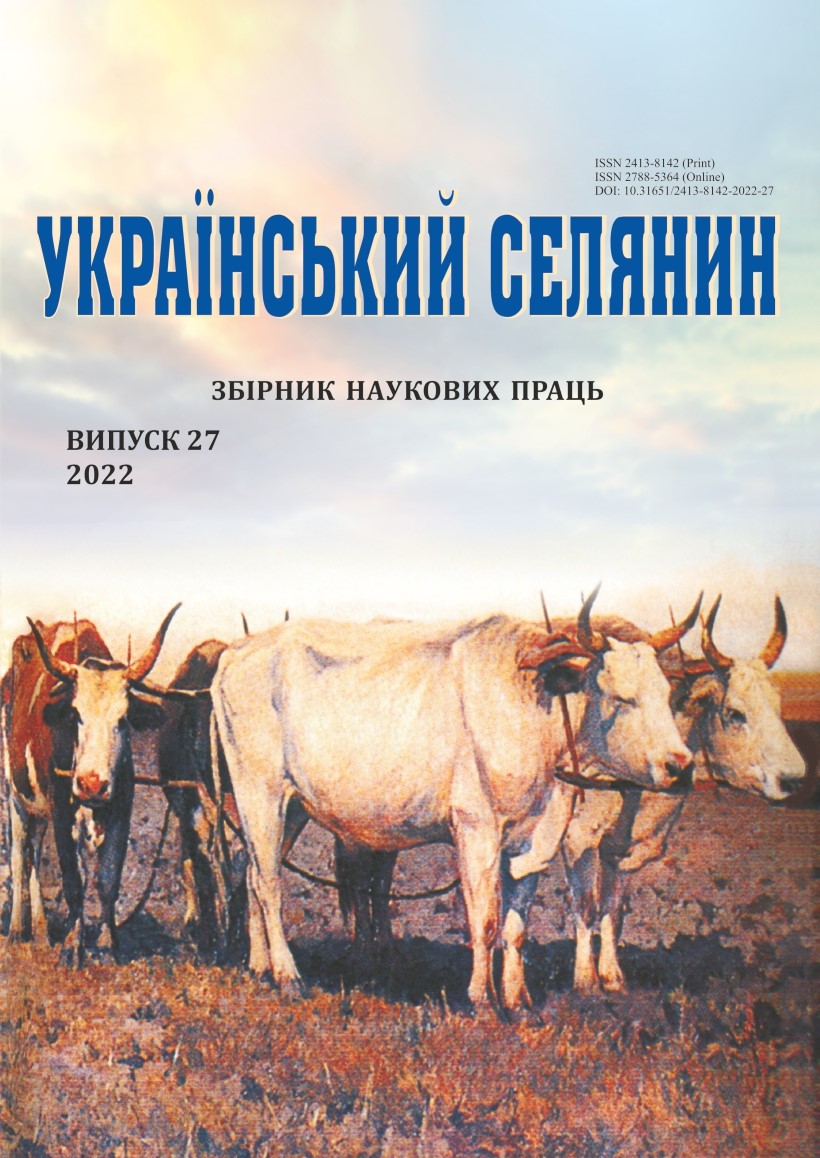Ukrainian “kurkuls” – the victims of the Bolshevik policy of social-chauvinism.
Main Article Content
Abstract
Abstract. The purpose of the article is a scientific and historical study of the political circumstances of the chauvinistic
attitude of the Bolshevik totalitarian regime towards Ukrainian «kurkuls», to identify the factors of the situational interpretation
of the socio-economic type of «kurkul farms».
The scientific novelty consists in the theoretical substantiation of the concept of «social chauvinism», as well as in the
coverage of this historical phenomenon in the Ukrainian village.
Conclusions. In the 20th century two anti-human ideologies arose and functioned – national socialism in Germany and
social chauvinism in the USSR. They differed in origin, but had a common feature – hatred of social, ethnic, national and political
groups of society. The socio-political intolerance of the Bolsheviks towards the wealthy classes (entrepreneurs, farmers, wealthy
peasants, artisans) was an organic component of their ideology, theory and practice of socialist construction. It is noted that
the classic socio-economic characteristics of «Kurkul farms» in 1929 were supplemented by political and ideological labels
in the conditions of collectivization and grain procurement. Under such circumstances, the quantitative growth of « kurkuls»
was observed. Their social group was supplemented by “pidkurkulnyks”, “saboteurs”, “speculators”, “rural bourgeoisie”,
etc. The historical form of realization of social chauvinism was the policy of dispossession (dekurkulization). It was carried
out by confiscation of land and property, economic restrictions, administrative pressure, relocation of “kurkuls” to so-called
“villages” and deportation outside the USSR. The liquidation of the “kurkuls” as a class actually ended in 1933, but the
chauvinistic attitude towards their “remnants” (Stalin’s expression) did not disappear. The liquidation of the “kurkuls” turned
out to be their banal economic robbery by the Soviet authorities.
Article Details
References
Volosnyk, Yu. (2002). Nova burshuasija Ukrainy ta rozvytok pryvatnopidpryemnyz’koi dijal’nosti na finansovomu
rynku v roky nepu. [The new bourgeoisie of Ukraine and the development of private business activity in the financial market
during the NEP years]. Kharkiv: NMZ «SD». [in Ukrainian].
Vodotyka, S. & Mazur, I. (1983). Zminy v sozial’no-klasovyi strukturi seljanstva Ukrainy. [Changes in the social-class structure of the peasantry of Ukraine] Ukrains‘kyi istorychnyi zhurnal. [Ukrainian historical journal]. 2, 42–51 [in Ukrainian].
Holod v SSSR. 1929–1934. [Famine in the USSR. 1929–1934 In 3 volumes. V.2. July 1932 - July 1933] (2012) (Ed.
V. Kondrashyn) Moskva: MFD, 2.
Holodomor 1932-1933 rokiv v Ukraini: dokumenty i materialy / Uporjad. R.Pyrih (2007). Kyiv: Vyd. Dim Kyivo-
-Mohylanska akademija. [in Ukrainian].
Dodatok do knyhy «Perepys naselennja» (1936). Kyiv: Vyd-vo Akad. nauk [in Ukrainian].
Zbirnyk statystychno-ekonomichnykh vidomostei pro sil’s’ke hospodarstvo Ukrainy. Vypusk 1. (1930). Kyiv: Vyd-
-vo «Narodne hospodarstvo a oblik» [in Ukrainian].
Zemskov, V. (2005). Spezposelenzy v SSSR, 1930–1960. Moskva: Nauka [in Russian].
Kalinichenko, V. (1997). Seljans’ke hospodarstvo Ukrainy v period nepu: Istoryko-ekonomichne doslidzhennja.
Kharkiv: Osnova [in Ukrainian].
Kolektyvisatsija i holod na Ukraini. Zbirnyk dokumentiv a materialiv / Uporjad. H.M.Mykhailenko, E.P.Shatalina
(1993). Kyiv: Naukova dumka [in Ukrainian].
Kul’chytskyi, S. (2007). Holodomor 1932–1933 rr. jak henozyd: trudnoshchi usvidomlennja. [Holodomor as genocide: difficulties of awareness]. Kyiv: Nash chas. [in Ukrainian].
Lasurenko, V. (2005). Kurkul chy hospodar? Seljans’ka ekonomika jak sozialna katehorija. [Toad or master? Peasant
economy as a social category] Cherkasy: Vash dim. [in Ukrainian].
Romanez, N. (2014). Represyvna polityka radjans’koii vlady v ukrains’komu seli (1925–1939). [The repressive
policy of the Soviet authorities in the Ukrainian countryside (1925–1939)] Kryvyi Rih: Vyd. Roman Kozlov. [in Ukrainian].
Svjatez, Yu. (2007). Ukrains’kу seljans’ke hospodarstvo ta nova ekonomichna polityka (kliometrychnyi analis sozialno-ekonomichnoho prozesu). [Ukrainian peasant economy and new economic policy (cliometric analysis of the socio-economic process)] Dnipropetrovsk: DMU. [in Ukrainian].
Stalin, I. (1950). Tvory. [Writings], Kyiv: Politvydav, 12. [in Ukrainian].
Stalin, I. (1951). Tvory. [Writings]. Kyiv, 13. [in Ukrainia].
Sushko, O. (2003). Osoblyvosti stanovlennja ta funkzionuvannja pryvatnoho pidpryemnyztva v Ukraini periodu
NEPu (1921–1928). [Peculiarities of the formation and functioning of private entrepreneurship in Ukraine during the NEP
period (1921–1928): historical and theoretical aspect]. Kyiv: Presa Ukrainy. [in Ukrainian].
Khomenko, A. (1935). Tempy spadannja dytjachoi smertnosti v USRR na pochatku pershoi p’tyrichky. [The rate of
decline in child mortality in the USSR at the beginning of the first five-year period]. Profilaktychna medyzyna. [Preventive
medicine].8–9, 89–96. [in Ukrainian].
Zbirnyk statystychno-ekonomichnykh vidomostei pro silske hospodarstvo Ukrainy. [Collection of statistical and economic information on agriculture of Ukraine]. (1929). Kharkiv, 1.
Zemskov, V. (2005). Spetsposelentsy v SSSR. 1930–1960. [Special settlers in the USSR. 1930–1960]. Moskva:
Nauka. [in Russian].
Zentral’nyi derzhavnyi arkhiv vyshchykh orhaniv vlady Ukrainy (ZDAVO Ukrainy). Fond 4402. Opys 1. Sprava
ZDAVO Ukrainy. F. 559. Op.1. Spr. 1654, 1665.
ZDAVO Ukrainy. F. 318. Op.1. Spr. 280.

